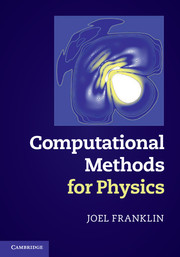
-
Select format
-
- Publisher:
- Cambridge University Press
- Publication date:
- July 2013
- May 2013
- ISBN:
- 9781139525398
- 9781107034303
- Dimensions:
- (247 x 174 mm)
- Weight & Pages:
- 0.98kg, 420 Pages
- Dimensions:
- Weight & Pages:
- Subjects:
- Physics and Astronomy, Mathematical Methods
You may already have access via personal or institutional login- Subjects:
- Physics and Astronomy, Mathematical Methods
Book description
There is an increasing need for undergraduate students in physics to have a core set of computational tools. Most problems in physics benefit from numerical methods, and many of them resist analytical solution altogether. This textbook presents numerical techniques for solving familiar physical problems where a complete solution is inaccessible using traditional mathematical methods. The numerical techniques for solving the problems are clearly laid out, with a focus on the logic and applicability of the method. The same problems are revisited multiple times using different numerical techniques, so readers can easily compare the methods. The book features over 250 end-of-chapter exercises. A website hosted by the author features a complete set of programs used to generate the examples and figures, which can be used as a starting point for further investigation. A link to this can be found at www.cambridge.org/9781107034303.
Reviews
'Computational Methods for Physics by Joel Franklin is a numerical analysis text written from the point of a physicist and pitched at upper-level physics students. It is different from what you might see in a text written by an applied mathematician. The core [chapters] of the text … each … [discuss] a numerical method … and … [have] a section on the physical motivation for needing the technique. In addition there are chapters on chaos and neural networks. Each chapter contains a good list of problems, both mathematical and computational. … This text is an excellent introduction to using numerical methods …'
Jan Tobochnik Source: American Journal of Physics
'Joel Franklin’s approach in this text is very much that of the physicist, in that he takes great pains to demonstrate the range of physical problems to which each computational technique might be applied before introducing the numerical method itself. … This book takes an original approach to teaching numerical methods to undergraduate physicists, and broadly succeeds in its task. There is a good range of material, and it is clearly presented at an appropriate level. It has great potential as a course text.'
A. H. Harker Source: Contemporary Physics
Contents
Metrics
Full text views
Full text views help Loading metrics...
Loading metrics...
* Views captured on Cambridge Core between #date#. This data will be updated every 24 hours.
Usage data cannot currently be displayed.
Accessibility standard: Unknown
Why this information is here
This section outlines the accessibility features of this content - including support for screen readers, full keyboard navigation and high-contrast display options. This may not be relevant for you.
Accessibility Information
Accessibility compliance for the PDF of this book is currently unknown and may be updated in the future.


